Mines in Canada Jeopardize Alaska Fisheries
Blog by Jenny Weis, Trout Unlimited
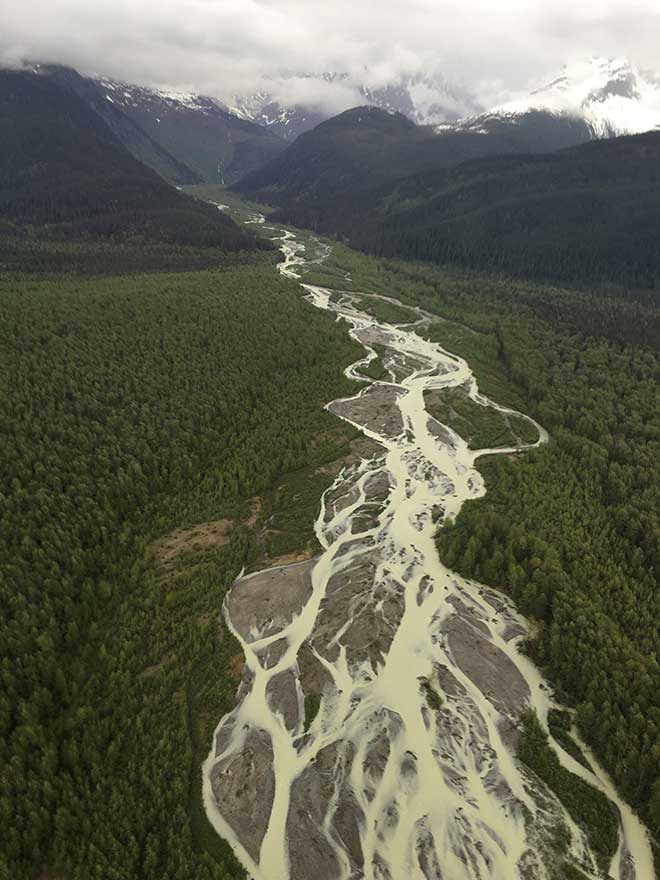
The Taku River valley from above. © Erin Hiest
Canadian mines jeopardize powerhouse Alaska fisheries
If you’re the type of angler who likes a quiet river – I mean, really quiet – with big fish, an occasional bear, and nothing man-made on the horizon, you should, but probably don’t, have the transboundary rivers of northwest British Columbia and southeast Alaska on your radar.
Brad Elfers described chasing Dolly Varden, Chinook, rainbow, cutthroat and bull trout at the headwaters of the Taku River. He said many of those native fish may live their entire lives without ever seeing another angler chasing them.
Needless to say, the headwaters of the Taku, Stikine, and Unuk Rivers, which flow from the Canadian side through the Alaska panhandle and into the Gulf of Alaska, benefit in terms of fish values from their obscurity.
You will probably never get to go there – there aren’t lodges, guides, or even many pilots to speak of who’ll take you there. But I’ll wager a bet that I’m not the only angler that imagines a place just like those headwaters when I consider what quintessential fly fishing looks like.
“It’s wild, wild country.”
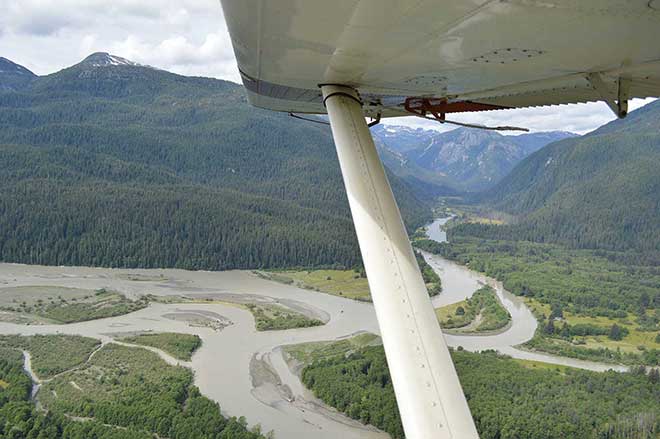
The Unuk River valley from above. © Evan Fritz
Elfers is the owner of Alaska Fly Fishing Goods based in Juneau. He’s done a few trips up the Taku River, the mouth of which is just east of Juneau.
“We always nervously joke when we’re up there that it’s kind of like being on the moon. It’s awfully hard for someone to come help you if you screw up.”
Though fly fishing may not be much of an “industry” on the Taku, Stikine and Unuk, the fish these watersheds produce are big business for Alaska. The three rivers contribute significant value to the commercial and subsistence fisheries in the region, which uphold more than 7,000 jobs in Southeast Alaska and supply $1 billion into the regional economy every year.
Historically, the Taku is Southeast Alaska’s largest salmon producer, with the region’s most prolific runs of coho and king salmon, with the Stikine usually a close second. The Unuk is one of Southeast’s top five king salmon producers and its hooligan (eulachon) run provides an important customary and traditional fishery. With king salmon populations dwindling across the Pacific Northwest, these watersheds are even more precious.
While all this fishing and economic activity unfolds downstream each year, upstream in Canada a major problem is brewing.
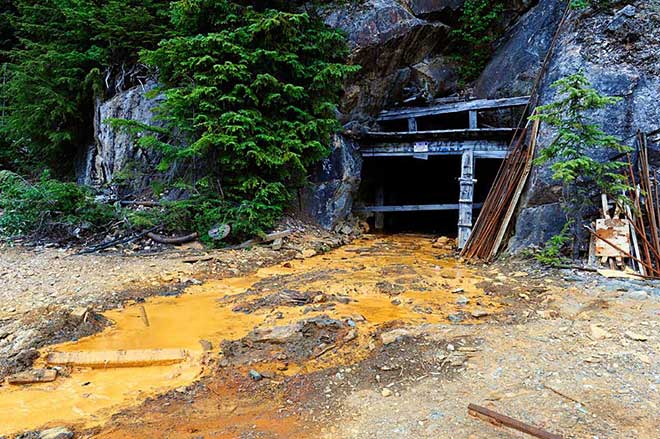
© Chris Miller
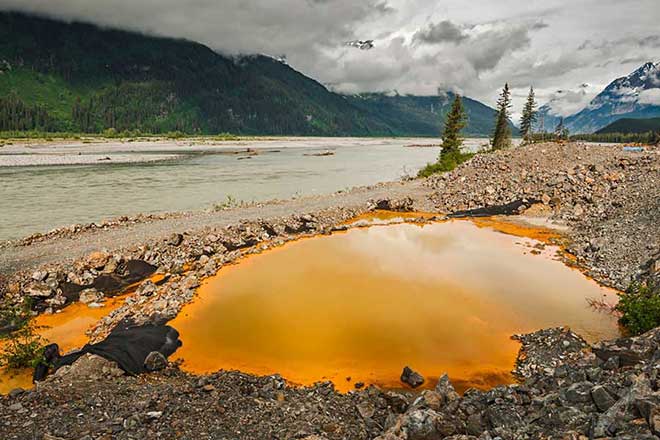
Acid drainage from the Tulsequah Chief Mine discolors a leaking containment pond next to the Tulsequah River in British Columbia, Canada, just above the Alaska border. © Chris Miller
Thanks to deregulation of environmental policies, along with a new transmission line in British Columbia, there are now 18 large-scale mines in various stages of exploration, development, and operation in watersheds that flow from Canada into the United States. Together, they dwarf the potential impacts of the massive proposed Pebble mine. Lax mining regulations and low standards for financial assurances have encouraged the industry’s expansion in the region, at a potentially high cost to Alaska industries and fish – the type and scale of mining proposed are known to be specifically harmful to water quality and fisheries.
“Most folks in Southeast don’t know what the heck is going on up there,” said Elfers, though he did acknowledge most are aware of acid mine drainage leaching from the Tulsequah Chief mine into the Taku River since the 1960s.
“They’re pretty good at finding a way to not have to clean up their own mess,” he said.
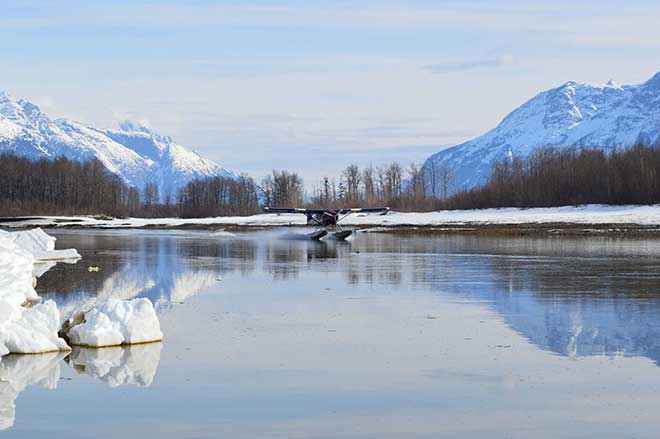
Remote is an understatement when it comes to these transboundary river systems. A landing on a Taku River tributary. © Evan Fritz
Alaska’s U.S. Senators Murkowski and Sullivan, Representative Young, and former Governor Bill Walker have this very concern on their radars. The group joined together, contacting Canadian officials to see to creating enforceable, comprehensive policies for upstream large-scale development, seeing that Alaska bears 100 percent of the environmental burden for the projects with none of the economic benefit. They said the lack of protections leave Alaska’s wild salmon, trout, steelhead, clean water, and the jobs these fisheries support vulnerable and at risk.
Yet, the enforceable protections have not advanced, and Alaska’s current Governor, Mike Dunleavy, has not picked up where his predecessor left off. This leaves Southeast’s fishing industries at risk, as well as the visions of sportsmen and women.
“If you really want to, you can always go there and fish. But even if you can’t go there to fish it’s really nice to know places like that are still around and still incredibly wild,” said Elfers. “It’s a situation you don’t find any more on the west coast of the United States. They’re really special places and really just, not a place to go drop a mine in.”
It’s no secret that king salmon stocks from California to Alaska are experiencing downturns in production, and the transboundary rivers of southeast Alaska are no exception. In 2004, the Taku, Stikine, and Unuk hosted a combined spawning escapement of over 121,000 kings; by 2018, that number had fallen over 90 percent, with fewer than 12,000 kings returning to spawn. The drivers of this stock decline aren’t fully understood, but one thing remains clear – in this period of rebuilding, the last thing these famous fish need is to shoulder the burden of potential habitat damage from mining operations.
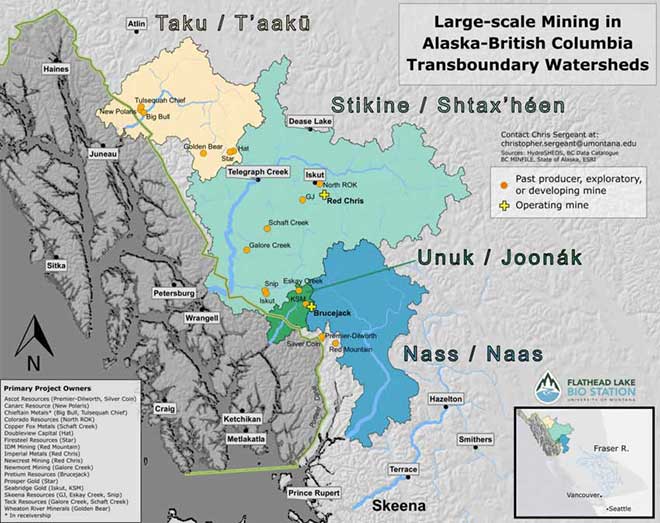
An overview map of the BC—Alaska area where mines lie on some of the most prolific salmon-producing watersheds in the southeast Alaska region. © Chris Sergeant
Fishing and development don’t have to be at odds. But when the development is done hastily and on waters that anglers cherish, it turns up the noses of people who value wild, productive waters and the many thousands who rely on those very headwaters for the commercial or subsistence catch that allows them to put food on their tables.
It’s simple to Elfers.
“The transboundary rivers do support a tremendous number of commercial fisheries and subsistence fisheries. They’re just not developed – that’s why they’re so productive still and such special places,” he said.
The State of Alaska has its work to do coordinating with the federal governments of the United States and Canada to ensure mining errors or worse – failures – in Canada don’t spell economic disaster for Alaskans.
If anglers are interested in seeing those rare places persist, they can demand U.S. decision makers weigh in. That is, they should do so if they understand that “seeing those rare places” is likely meant figuratively, not literally.
This blog originally appeared as the Conservation column, titled ‘Canadian Mines Jeopardize Powerhouse Alaska Fisheries’ in the August/September 2020 issue of Fish Alaska.
